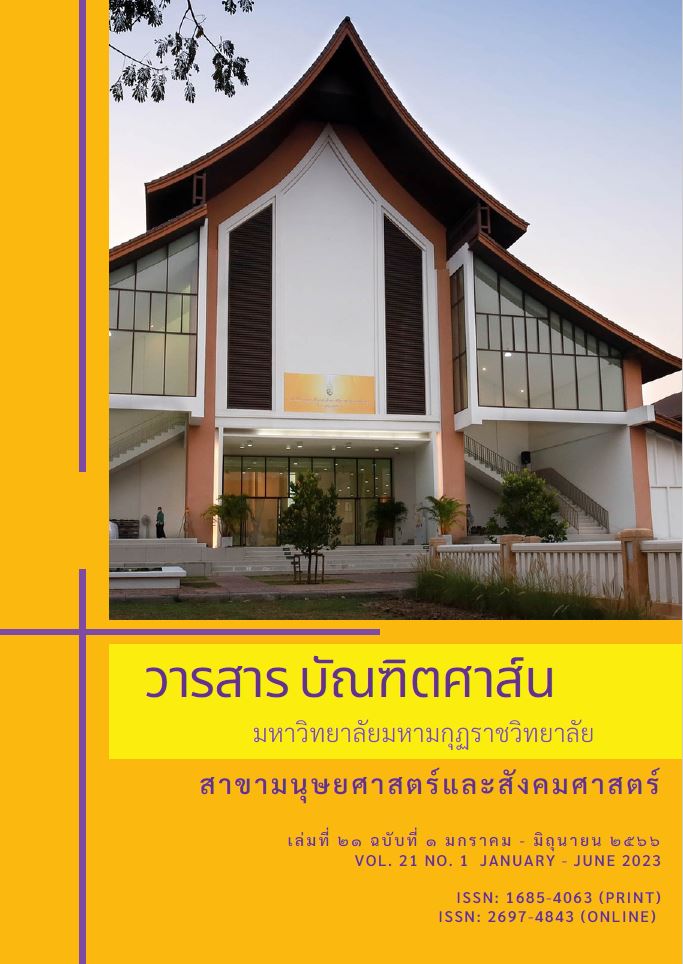นวัตกรรมการบริหารงานบุคคลในยุคฐานวิถีชีวิตใหม่ ตามหลักสังคหวัตถุ 4 ของผู้บริหารโรงเรียนประถมศึกษา จังหวัดนครนายก
คำสำคัญ:
นวัตกรรมการบริหาร, ฐานวิถีชีวิตใหม่, หลักสังคหวัตถุ 4บทคัดย่อ
การวิจัยเรื่อง นวัตกรรมการบริหารงานบุคคลในยุคฐานวิถีชีวิตใหม่ ตามหลักสังคหวัตถุ 4 ของผู้บริหารโรงเรียนประถมศึกษา จังหวัดนครนายก มีวัตถุประสงค์เพื่อ 1. เพื่อศึกษาสภาพปัจจุบัน ปัญหาการบริหารงานบุคคล ในยุคฐานวิถีชีวิตใหม่ของผู้บริหารโรงเรียนประถมศึกษา 2. เพื่อศึกษาวิธีการของนวัตกรรมการบริหารงานบุคคลในยุคฐานวิถีชีวิตใหม่ตามหลักสังคหวัตถุ 4 ของผู้บริหารโรงเรียนประถมศึกษา และ 3. เพื่อเสนอแนวทางการพัฒนานวัตกรรมการบริหารงานบุคคลในยุคฐานวิถีชีวิตใหม่ตามหลักสังคหวัตถุ 4 ของผู้บริหารโรงเรียนประถมศึกษา จังหวัดนครนายก ใช้ระเบียบวิธีวิจัยแบบแบบผสานวิธีระหว่างการวิจัยเชิงปริมาณและเชิงคุณภาพ ใช้กลุ่มตัวอย่างผู้บริหารและครูในอำเภอบ้านนา จังหวัดนครนายก จำนวน 196 คน เก็บรวบรวมข้อมูลแบบสอบถามความคิดเห็น ใช้สถิติวิเคราะห์หาค่าเฉลี่ยและค่าส่วนเบี่ยงเบนมาตรฐาน และสัมภาษณ์ผู้ทรงคุณวุฒิ เพื่อนำผลจากการสัมภาษณ์มาสนับสนุนงานวิจัยเชิงปริมาณเกี่ยวกับหลักการและนวัตกรรมการบริหารงานบุคคลในยุคฐานวิถีชีวิตใหม่ ตามหลักสังคหวัตถุ 4 ของผู้บริหารโรงเรียนประถมศึกษา จังหวัดนครนายก
ผลการวิจัย พบว่า
- ผู้บริหารและครูมีความคิดเห็นต่อสภาพปัญหาและการบริหารงานบุคคลในยุคฐานวิถีชีวิตใหม่ของผู้บริหารโรงเรียนประถมศึกษา โดยภาพรวมอยู่ในระดับมาก ได้แก่ ด้านการประเมินผลการปฏิบัติงาน ด้านการสรรหาและคัดเลือก ด้านการฝึกอบรมพัฒนา และด้านค่าตอบแทน ตามลำดับความสำคัญต่อสภาพการบริหารงานบุคคลของผู้บริหารโรงเรียนประถมศึกษา จังหวัดนครนายก
- วิธีการนวัตกรรมการบริหารงานบุคคลในยุคฐานวิถีชีวิตใหม่ตามหลักสังคหวัตถุ 4 มีดังนี้ 1) ด้านการประเมินผลการปฏิบัติงาน 2) ด้านการสรรหาและคัดเลือก 3) ด้านการฝึกอบรมพัฒนา 4) ด้านค่าตอบแทน ยุคฐานวิถีชีวิตใหม่ตามหลักสังคหวัตถุ 4 ได้แก่ (1) ทาน ให้การเอื้อเฟื้อกับทุกคน (2) ปิยวาจา การพูดสื่อสารด้วยความสุภาพ (3) อัตถจริยา เข้าไปมีส่วนร่วนในการบำเพ็ญประโยชน์ (4) สมานัตตตา ให้ความยุติธรรมกับทุกคน เป็นวิธีการบริหารงานบุคคลให้เกิดการเปลี่ยนแปลงสู่วิถีใหม่ภายใต้แนวคิดใหม่ วิธีการใหม่ กระบวนการใหม่ในการพัฒนาการบริหาร
- แนวทางการพัฒนานวัตกรรมการบริหารงานบุคคลตามหลักสังคหวัตถุ 4 มีดังนี้
3.1 ด้านการสรรหาและคัดเลือก 1) ทาน บริหารให้โอกาสกับบุคลากรเข้ารับการคัดเลือก 2) ปิยวาจา ใช้วาจาสื่อสารด้วยคำพูดไพเราะ 3) อัตถจริยา ทำในสิ่งที่เป็นประโยชน์ต่อสถานศึกษา 4) ด้านสมานัตตตา ผู้บริหารควรมีความเสมอต้นเสมอปลายกับทกคน
3.2 ด้านการฝึกอบรมพัฒนา 1) ทาน ผู้บริหารสร้างโอกาสกับบุคลากรทุกคนให้ได้รับการพัฒนา 2) ปิยวาจา ควรให้แนะนำด้านการพัฒนางานวิชาการเพื่อนำไปพัฒนาการศึกษา 3) อัตถจริยา ควรส่งเสริมพัฒนาศักยภาพบุคลากรให้มีทักษะการทำงาน 4) สมานัตตตา ผู้บริหารควรเป็นกัลยาณมิตรกับบุคลากรทุกคนในการทำงาน
3.3 ด้านค่าตอบแทน 1) ทาน ผู้บริหารควรกำหนดค่า ตอบแทนเพื่อให้เป็นรางวัลบุคลากร 2) ปิยวาจา พูดให้คำชื่นชม ยกยอผู้ใต้บังคับบัญชาที่สร้างชื่อเสียงกับโรงเรียน 3) อัตถจริยา ผู้บริหารควรจัดให้มีสวัสดิการแก่บุคลากรในโรงเรียน 4) สมานัตตตา ผู้บริหารควรให้บุคลากรทุกคนได้รับสวัสดิการหรือค่าตอบแทนอย่างมีความยุติธรรม
3.4 ด้านการประเมินผลการปฏิบัติงาน 1) ทาน ผู้บริหารควรส่งเสริมให้บุคลากรได้รับการพัฒนาด้านนวัตกรรมในยุคฐานวิถีชีวิตใหม่เกี่ยวกับการประเมินผลการปฏิบัติงาน 2) ปิยวาจา ควรประชาสัมพันธ์และให้ความรู้นวัตกรรมแก่บุคลากรได้นำนวัตกรรมมาพัฒนาระบบข้อมูลการประเมินผลการปฏิบัติงาน 3) อัตถจริยา ให้การสงเคราะห์ในสิ่งที่เป็นประโยชน์ต่อบุคลากร และ 4) สมานัตตตา ผู้บริหารควรรักษาระเบียบวินัยกับทุกคนพึงปฏิบัติทั้งผู้ใหญ่ทั้งผู้น้อยตามหน้าที่ ด้วยความเสมอต้นเสมอปลาย
เอกสารอ้างอิง
กรมสวัสดิการและคุ้มครองแรงงาน. แผนกลยุทธ์การบริหารทรัพยากรบุคคล กรมสวัสดิการและคุ้มครองแรงงานปีงบประมาณ พ.ศ. 2564-2565. กรุงเทพมหานคร: กลุ่มงานพัฒนาระบบงานและอัตรากำลังกองการเจ้าหน้าที่กรมสวัสดิการและคุ้มครองแรงงาน, 2564.
กิดานันท์ มลิทอง. เทคโนโลยีการศึกษาและนวัตกรรม. กรุงเทพมหานคร: จุฬาลงกรณ์มหาวิทยาลัย, 2540.
จอมพงศ์ มงคลวนิช. การบริการองค์การและบุคลากรทางการศึกษา. พิมพ์ครั้งที่ 2.กรุงเทพมหานคร: พิมพ์ที่ บริษัททวี พริ้นติ้ง, 2556.
ธานินทร์ ศิลป์จารุ. การวิจัยและการวิเคราะห์ข้อมูล ทางสถิติด้วย SPSS และ AMOS. พิมพ์ครั้งที่ 17. กรุงเทพมหานคร: เอส.อาร์.พริ้นติ้ง แมสโปรดักส์, 2560.
พระพรหมคุณาภรณ์ (ป.อ.ปยุตโต). พจนานุกรมพุทธศาสตร์ ฉบับประมวลธรรม. พิมพ์ครั้งที่ 13. กรุงเทพมหานคร: บริษัท เอส.อาร์.พริ้นติ้งแมส โปรดักส์, 2548.
พระครูสิทธิวรธรรมวิเทศ จารุธมฺโม (ลือบางใหญ่). “การพัฒนาการบริหารบุคลากรในสถานศึกษาตามหลักไตรสิกขาโรงเรียนประถมศึกษา สำนักงานเขตบางกอกใหญ่กรุงเทพมหานคร”. วิทยานิพน์พุทธศาสตรมหาบัณฑิต สาขาวิชาการบริหารการศึกษา. บัณฑิตวิทยาลัย: มหาวิทยาลัยมหาจุฬาลงกรณราชวิทยาลัย, 2559.
วิลาวรรณ เสนนอก. “การบริหารงานบุคคลของผู้บริหารสถานศึกษาตามหลักสัปปุริสธรรม 7 สำนักงานเขตพื้นที่การศึกษาประถมศึกษาปทุมธานี เขต 1”. วิทยานิพนธ์พุทธศาสตรมหาบัณฑิต, สาขาวิชาการบริหารการศึกษา. บัณฑิตวิทยาลัย: มหาวิทยาลัยมหาจุฬาลงกรณราชวิทยาลัย, 2557.
ลมเปลี่ยนทิศ. การบริหารทรัพยากรบุคคล. [ออนไลน์]. แหล่งที่มา: https://www. salika.co / 2020/0810/howto-manage-human-capital-fight [10 มิถุนายน 2564].
ดาวน์โหลด
เผยแพร่แล้ว
รูปแบบการอ้างอิง
ฉบับ
ประเภทบทความ
สัญญาอนุญาต
ลิขสิทธิ์ (c) 2023 มหาวิทยาลัยมหามกุฏราชวิทยาลัย

อนุญาตภายใต้เงื่อนไข Creative Commons Attribution-NonCommercial-NoDerivatives 4.0 International License.
บทความวิชาการและบทความวิจัยในวารสารฉบับนี้ถือเป็นความรับผิดชอบของผู้เขียนเท่านั้น บทความที่ได้รับการตีพิมพ์ในวารสารบัณฑิตศาส์น ถือเป็นลิขสิทธิ์ของมหาวิทยาลัยมหามกุฏราชวิทยาลัย ตามพระราชบัญญัติลิขสิทธิ์



